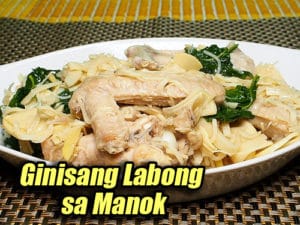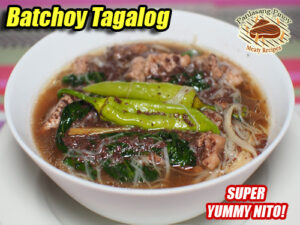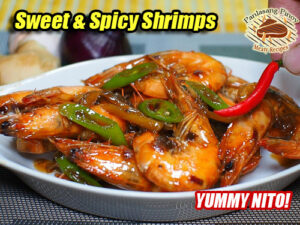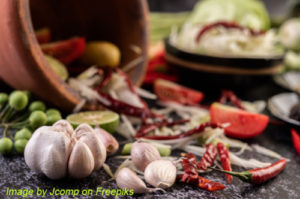This is one of my favorite comfort food because of the fact that I like noodles of every kind. This dish is made up of combining patola (luffa), pork, shrimp and misua or miswa, a very thin thread-like Chinese salted noodles made from wheat flour, eggs and of course salt and water. I think this noodles is one of the things we inherited from the early Chinese immigrants. This dish is very simple, healthy and easy to digest. It is also one of the cheapest dished you can make. So if you want to stretch your budget and make a delicious viand, then I think you should give this dish a try.
Ginisang Patola with Misua: A Simple Yet Nostalgic Dish
Growing up in a bustling household, meals often became a time for everyone to reconnect, even amid busy schedules. There was one dish, in particular, that brought back childhood memories every time it was served: Ginisang Patola with Misua. This dish is not just a simple combination of luffa, pork, shrimp, and thin misua noodles—it’s a comforting bowl of warmth that feels like a tight hug from a loved one.
I remember my grandmother making this dish on rainy days. The kitchen would fill with the aroma of garlic and onions sautéing in oil, a smell so inviting that we’d all start gravitating toward the stove, hoping to sneak a taste. Though the recipe is humble and straightforward, it holds a special place in my heart and continues to be a favorite to this day.
A Nod to Tradition
While this noodle soup is an easy and affordable meal, its roots are rich in history. The thin, delicate noodles used in this dish, known as misua (or miswa), are a culinary gift from early Chinese immigrants who introduced many of their food traditions to the Philippines. Misua is made from wheat flour, eggs, salt, and water—ingredients so simple, yet they produce a noodle with a uniquely tender texture that almost melts in your mouth.
I once asked my uncle why this dish was so popular among our family, and his response was simple: “It’s filling, cheap, and reminds us of home.” And he was right. For many Filipino families, this dish has been a staple because it’s so easy to stretch a small budget while still providing a hearty meal.
The Humble Ingredients that Make It Special
At first glance, this noodle soup may seem like an ordinary dish, but it’s the layering of flavors and ingredients that makes it truly satisfying. One of the key components is patola, or luffa. When cooked just right, patola adds a subtle sweetness and a soft, sponge-like texture that absorbs the flavors of the broth beautifully.
Shrimp also plays an essential role in elevating the flavor of this simple dish. Rather than tossing the shrimp shells and heads, I’ve learned from my aunt to extract their juice by pouring hot water over them. This adds depth to the broth, giving it a rich umami taste. It’s these small steps, like creating shrimp juice, that make all the difference.
The pork adds heartiness, while fish sauce brings a distinctive saltiness that ties all the flavors together. When the patola starts to soften and the noodles have soaked up the savory broth, that’s when I know the dish is ready—each bite is a combination of tender pork, sweet shrimp, and soft noodles swimming in a flavorful broth.
Easy and Comforting for Every Occasion
What makes this dish a favorite in my home, aside from its affordability, is how quickly it comes together. As someone who enjoys cooking but doesn’t always have the luxury of time, I appreciate recipes that can be whipped up with minimal fuss. And this dish delivers exactly that.
In just about 30 minutes, you can have a pot of comforting noodle soup that’s perfect for any occasion. Whether it’s the middle of a hectic weekday or a quiet evening at home, this simple noodle soup has a way of soothing both the body and the soul.
But don’t let the simplicity fool you—this dish is packed with nutrition. Patola is rich in vitamins and minerals, while the shrimp and pork provide essential proteins. Combined with the thin noodles, it’s a meal that’s both light and filling, ideal for those who want something nutritious but easy on the stomach. When I serve this at family gatherings, it’s often gone in minutes because of how flavorful and easy to digest it is.
Tips for Perfecting the Dish
One trick I learned from my cousin, who is the cook of the family, is not to overcook the noodles. Misua cooks incredibly fast, so the moment you add it to the pot, you’ll want to keep an eye on it. A couple of minutes are all it takes to ensure the noodles are tender without turning mushy.
Another tip is to adjust the saltiness to your liking. The fish sauce can be quite strong, so start with a small amount and add more if necessary. I’ve noticed that my sister prefers it on the milder side, while my father likes a good punch of saltiness, so I often leave the fish sauce on the table for everyone to adjust their own bowls.
A Dish that Stands the Test of Time
The beauty of this dish lies in its ability to adapt and endure. Over the years, I’ve seen different versions of this recipe—some people prefer to omit the pork, while others add more vegetables, such as carrots or squash, for added nutrition. In fact, I recently saw a version where tofu replaced the meat, making it a vegetarian-friendly dish.
Whether it’s a rainy afternoon or a special family gathering, this noodle soup never fails to bring warmth and joy to the table. The delicate, almost nostalgic flavor of misua paired with the tender patola and savory broth creates a dish that’s both simple and special. Every spoonful transports me back to my grandmother’s kitchen, surrounded by the laughter of family and the love that was always served alongside every meal.
So the next time you find yourself craving something comforting and easy to prepare, I suggest giving this dish a try. It’s a taste of tradition and simplicity, a dish that’s as satisfying as it is timeless.
Ginisang Patola with Misua
Ingredients
- 1 pc large patola luffa
- 100 grams pork cut into small cubes
- 100 grams shrimps shelled (save the shell and head)
- 2 rolls misua Chinese Vermicelli noodles
- 1 pc onion chopped
- 3 cloves garlic minced
- 2 Tbsp. fish sauce patis
- 4 cups water
- 1 tsp MSG or granulated seasoning optional
- salt to taste
- 2 Tbsp. cooking oil
Instructions
How to cook ginisang patola with misua:
- Peel the patola, slice into thick roll pieces. Set aside.
- Make shrimp juice by pouring 1/2 cup hot water on the shrimp shells and heads. Using a sieve, separate the shells and heads of the shrimp and collect the liquid. The liquid is the shrimp juice.
- Saute garlic until brown, add onion and when it becomes soft, add the pork.
- Saute again for 2 minutes, add 1/2 cup water and cover. Cook until the pork is tender.
- Add shrimp and patis. Stir. Then pour in shrimp juice. Stir gently until it boils. Add the patola and MSG.
- When patola is almost cooked, add the misua. Cook again for about 2 minutes and serve hot.
Notes
Cooking Tips:
Don’t Overcook the Misua
Misua cooks very quickly and can become mushy if left too long in the pot. To maintain the perfect texture, add the noodles in the last few minutes of cooking and keep an eye on them. Once they soften, turn off the heat to prevent them from overcooking in the residual heat.Maximize Flavor with Shrimp Juice
Instead of discarding the shrimp heads and shells, use them to make shrimp juice by steeping them in hot water. This simple technique adds a rich umami flavor to the broth, enhancing the overall taste of the dish. It’s an easy way to boost flavor without additional ingredients.Add Patola at the Right Time
Patola softens quickly, so be mindful not to add it too early in the cooking process. For a tender yet firm texture, add the patola just before the noodles and let it cook for a few minutes until it absorbs the flavors of the broth. This ensures the patola retains its shape and texture without becoming too soft.






Hi Monica, it’s similar to MSG and the usual brand name is magic sarap or Namnam. Its optional so you can omit it.
What is the granulated seasoning? I dont want to use MSG.
This was delicious! My wife, who is Chinese, loved it also. I think this recipe will become one of my favorites. Thank you, Manny, for posting it.
Herman (in New York)
Hi Herman, thanks for sharing your experience and I do hope you will visit this often!